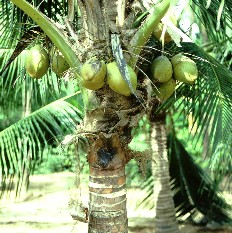By HARRY EAGAR, Staff Writer
KAHULUI – Can palm oil, or any other vegetable oil, be grown
sustainably to displace diesel oil in Hawaii?
Hawaiian Electric Co. says yes. There are at least 140,000 acres of
land in the islands that were once farmed but are now fallow.
At Monday's informational meeting in Kahului, several speakers were
just as skeptical of local oil as they were of imported palm oil.
Robbie Alm of HECO said the University of Hawaii-Hilo, the Hawaii
Agricultural Research Center and others are experimenting with fuel
crops.
Most enthusiasm focuses on jatropha, a desert plant that requires very
little water; and algae, which would require very little land.
With algae, the goal of cutting carbon emissions would be a two-fer:
The algae would provide a fuel with almost no net carbon emissions,
and their growth could be enhanced by feeding them carbon dioxide
produced at Maui Electric Co.'s generators in Maalaea.
One speaker objected to jatropha's toxic seeds.
Several complained that Hawaii's potential demand for biofuel could
use up every available acre, leaving nothing to grow food. (Not
mentioned by anyone at Monday's meeting is the estimate made by the
state Department of Agriculture that all of Hawaii's needs for fruits
and vegetables could be satisfied on about 5,000 acres.)
The one potential fuel crop that everyone is certain can be grown
successfully in the islands is sugar cane, but that yields alcohol,
not diesel oil.
Ralph Cavanagh of the Natural Resources Defense Council said study is
needed to determine the net energy balance of palm oil grown anywhere.
In the case of ethanol derived from corn grown in the Midwest, it is
claimed it takes more energy to grow it than it yields. The claim is
vigorously denied, and the calculations depend, in part, on what is
counted as input.
Corn grows readily in Hawaii but does not give the yields per acre per
planting that it obtains in Iowa. On the other hand, in Hawaii farmers
can get two, maybe three crops of corn per year.
HECO's plan is to use profits from refining biodiesel on Maui to
support research and development of local feedstocks.
Alm noted that it will require "tens of millions of dollars" of
infrastructural investment to produce large crops of biofuel plants.
Orchid grower Jeff Parker objected that no farmer will grow, say,
jatropha, for $500 an acre when "orchids return $100,000 to $300,000
per acre."
Hemp is out, says Alm, because it doesn't give very much oil. Besides,
it is illegal.
Hawaiian cultural advocate Leslie Kuloloio objected to African oil
palm as an "alien" plant. He demanded consultation with Hawaiian
kupuna on any crop.
Alm said the ideal crop would be one that "grows on rainfall," but he
acknowledged that any crop that requires irrigation would require some
fundamental decisions about water use.
Plantation diversions of water are under attack in several quarters,
including demands to restore natural stream flows and provide water to
taro farmers.
There are about 40,000 acres on Maui being cultivated in plantation
crops of sugar cane and pineapple.
--

1 comment:
Jatropha seeds are toxic when pressed. This concern is eliminated if press is an air-filtered contained system.
Jatropha crops are unpredicatable if you examine the current growing circumstances used for observations (dry arid climates).
If the climate of which it is grown is good agricultural land, it can yield up to 4 times more oil per acre than any other vegetable oil. This is why BP signed agreements to grow Jatropha in Florida this last June.
Toxicity concerns are no longer a concern.:)
Post a Comment